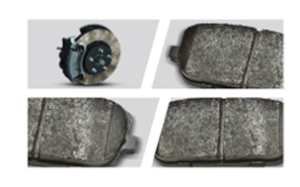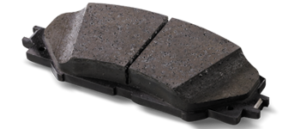Toyota Brake Pads
What is Brake Pad?
Brake pads are a crucial component in the braking system of vehicles. They are a part of disc brakes, which are commonly used in modern vehicles. When you press the brake pedal, the brake pads create friction against the rotating brake disc (or rotor), generating the necessary force to slow down or stop the vehicle.
Function of Brake Pads
Brake pads allow vehicles to stop by pressing on all the wheels of the brake rotor, which rotates with the wheels. Driving with worn out brake pads can be dangerous and can cause the vehicle to veer when stopping.
- Friction and Heat Generation:
- When the brake pedal is pressed, hydraulic pressure is applied to the brake caliper, which in turn squeezes the brake pads against the brake rotor (or disc in disc brake systems).
- The friction between the brake pads and the rotor generates heat. This heat is essential for the braking process but needs to be managed to prevent brake fade and other issues.
5. Noise Damping:
-
- Brake pads may include materials or features designed to dampen noise generated during braking. This helps reduce brake squeal or other unwanted sounds.
2. Conversion of Kinetic Energy to Thermal Energy:
-
- As the brake pads press against the rotating brake rotor, they convert the kinetic energy of the moving vehicle into thermal energy (heat). This process slows down the vehicle.
6. Material Composition:
- Brake pads are typically made from materials that provide the necessary friction characteristics while minimizing wear on the brake rotor. Common materials include organic compounds, semi-metallic materials, and ceramic materials.
3. Stopping the Vehicle:
- The primary function of brake pads is to create enough friction to slow down and eventually stop the vehicle.
- In disc brake systems, the brake pads clamp onto the rotating disc to create the necessary friction. In drum brake systems, the brake pads press against the inner surface of the drum.
7. Temperature Management:
- Brake pads must operate within a certain temperature range. If they get too hot, they can experience brake fade, reduced performance, or even damage. Quality brake pads are designed to handle the heat generated during braking without compromising performance.
4. Wear and Tear:
- Brake pads are designed to wear over time. They undergo controlled wear during braking, and this wear is a normal part of the braking system’s operation.
- Periodic replacement of brake pads is necessary as they wear down, ensuring the continued effectiveness of the braking system.
8. Consistent Performance:
- Brake pads need to provide consistent and predictable braking performance under various conditions, such as normal driving, emergency stops, and varying weather conditions.
Fake/Counterfeit Product
- Unreliable and poor durability
- May be made with environment damaging asbestos
- No anti skim-shim, thus more likely to squeak
- Low quality may cause brake failure
When is it time to change my Brake Pads?
- Squeaking noises
- Loss of braking power
- Wearing out

Genuine Toyota Brake Pads
- Special lining for balanced and stable braking in all temperatures
- Finely processed anti-skim shim to prevent brake noise
- Environment friendly
- Strict quality control inspection to ensure smooth braking

